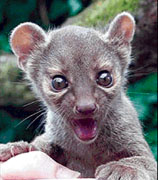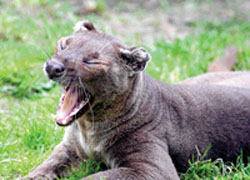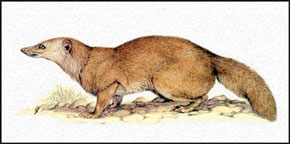Nature trail
Madagascarís endangered trio
The island of Madagascar (an African island in the Indian Ocean) is
home to a wide range of animal species, some of whom are strange in
appearance and also have some unusual names. We hope you enjoy learning
about many hitherto unknown creatures by taking a walk with us on the
Ďwild sideí through Nature Trail.
Today we decided to introduce you to three threatened species of
animals that are native to Madagascar; they are the fossa, fanaloka and
falanouc. Wondering for a moment whether we are making up these names?
No, they really are the names by which these animals are known, so letís
find out what exactly they are.
Fossa (Cryptoprocta ferox)
The fossa pronounced as foo sa (sounding similar to cat in Sinhala -
pussa), is a mammal endemic to Madagascar and belongs to the family of
Eupleridae (earlier classified as belonging to the family of Viverridae).
It is a relative of the mongoose, but has little resemblance to it.
 |
|
A baby fossa |
The fossa is more like a cross between a cat and a dog; itís very
similar in appearance to a mountain cat and in fact has been likened to
the clouded leopard, a felid native to southeast Asia. Not only its
appearance, but its behaviour too is very similar to that of cats.
Why it is said that this animal is like a cross between a cat and a
dog is due to its muzzle or snout which strongly resembles that of a
dog. Its head is small, ears too are small and rounded, but eyes are
large with pale fur around them. It has extremely long whiskers, about
32-36, fearsome, sharp but small cat-like teeth, and short, curved
claws. Its claws are retractable.
The fossaís coat is reddish brown in colour. It can weild its tail
like a tight-rope walkers pole for balancing. Male fossas are about
75-80 cm (29-31 in) long, with tails of 70-90 cm (27-35 in) in length.
It weighs about 6-10 kg (13-22 lbs). As in most other animals, the
female is smaller, reaching a length of 65-70 cm (25-27 in) and weighing
about 5-7 kg (11-15 lbs).
The tail length however is the same. It is considered to be the
largest mammalian carnivore on the isle of Madagascar. If you are
wondering who the largest of all carnivores, it is of course none other
than the Nile crocodile.
Now letís find out about the offspring. According to researchers, the
female does not breed until it is about four years old. If usually gives
birth to 2-4 young in a den after a gestation period of 90 days. The
fossa babies are born toothless and with closed eyes. They weigh about
three ounces each (100 gr.). They open their eyes after 15 days and are
very dependent on the mother for nearly an year. They donít even leave
the den until they are four months old.
 |
|
It is a good climber |
The little ones are weaned when they are about 4 1/2 months old. They
develop adult teeth only when they are two years old and reach adult
size at 4 years.
The fosses were once thought to be nocturnal, but new research has
revealed that they are active during both night and day. They are known
to be very agile creatures and in fact their agilility is compaired to
that of squirrels. They are good climbers and also have the ability to
leap from tree to tree. The fosses are also good runners and moves
swiftly trough forests.
These elusive creatures which spend time on the ground as well as
trees can be found in the deciduous forests of Madagascar, but
researchers claim that the numbers have reduced to around 2,500
individuals in the wild due to the loss of habitat and the animals being
killed by humans. They are classified as endangered. Average lifespan in
the wild is 15 years and 20 in captivity.
As carnivores, they are ferocious hunters and their diet comprises
small to medium sized animals including birds and fish. They are good at
hunting lemurs and Madagascar is home to about 30 species of lemurs.
Fanaloka (Fossa fossana)
It is believed that this species of animal which is also endemic to
Madagascar may have got this rather unusual name fanaloka from one of
the countryís native languages. However, it is also known as the
Malagasy or striped civet. Even though it is scientifically classified
as Fossa fossana and also Fossa fossa it should not be confused with the
fossa and the falanouc.
The fanaloka is also a small carnivorous mammal which strongly
resemble civets or small foxes with a face like a foxís. But it doesnít
have anal glands that civets have. It measures about 16 inches from head
to body, with another five inches added to this length by the tail.
 |
|
A sleepy fossa |
The weight is about 2.5 - 5 lbs. Its coat which is densely furred is
pale beige or greyish beige in colour with a series of darker markings
like spots or stripes running lengthwise from head to tail. The stripes
change into spots near the belly area. The underside is lighter. It has
a conspicuous(prominent) white patch on the head near the rear corner of
the ears. It has very slender and short legs and is not a good climber
like the fossa.
It is believed to be a nocturnal creature that lives in pairs or
alone in the heart of Madagascarís dry, deciduous forest. It preys on
small vertebrates and also insects. It is known to steal eggs from
nests.
The female gives birth to a single well developed, offspring after a
gestation of three months. The off spring is born with its eyes open,
unlike the young of the fosses. The little one is weaned of motherís
milk by the time itís 10 weeks old. It can walk within three days after
itís born and starts eating meat when itís about a month old.
The fanaloka stores fat reserves equalling 25 per cent of its body
weight in its tail to use during winter months.
Fanalouc (Eupleres goudoti)
Yet another endangered species in the island of Madagascar, the
fanalouc is also known as the Malagasy mongoose, Slender fanalouc or
small-toothed mongoose.
Found throughout the rainforests and lowland swamps of eastern
Madagascar, the fanalouc is grouped into two subspecies, the eastern
fanalouc and the western fanalouc. In general, the fanalouc has a
muscular body and is stocky in appearance. Its hind legs are larger than
its forelegs.
It is about 50cm in length. The tail which is wide and 24cm long is
cylindrical. It is used to store fat, just like the fanaloka. Its head
is long and narrow with a pointed muzzle. The teeth are similar to those
of insectivores. The claws are long and aid the animal in its digging
activities.
 |
|
It has a painted snout
and a thick tail. |
The coat which is dense with long guard hairs varies in colour. The
eastern fanaloucs have fawn coloured coats with cream underbellies. In
the western subspecies the females are grey and males are brown. These
nocturnal and solitary animals feed almost exclusively on earthworms and
occasionally on other invertebrates including insects, aquatic snail,
frogs, small birds and mammals.
They could be seen sometimes wading in water after prey. They also
forage through leaf litter for food. The fanaloucs generally sleep
inside logs or in rocky crevices. They are territorial.
The females give birth to one or two offspring between November and
January. The baby fanaloucs are about 5 oz at birth and fully covered in
fur. The eyes are open. The offspring could be seen foraging for food
with parents within two days of birth. They are weaned of motherís milk
by the time they are 9 weeks old.
Like the fossa and fanaloka, the fanalouc is also the only species in
the genus. And since they are all threatened species it is important to
protect them from disappearing from the face of the Earth, someday.
Weíll bring you more fascinating information about various animals
living in all parts of the world. Meanwhile, try to find out about the
animals that you are not so familiar with, that inhabit our planet. |
